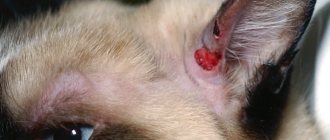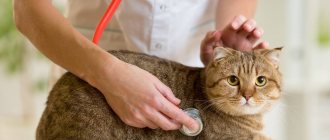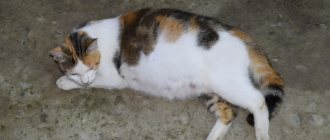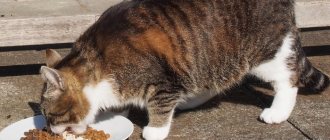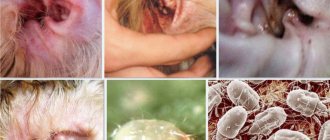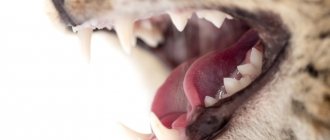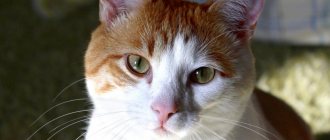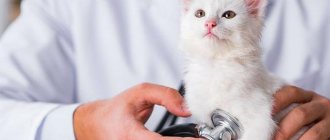- Animal cardiology
- Informational portal
- Gastroenterology of dogs
- Literature
Cleft palate and cleft lip type developmental anomaly in a Burmese cat
"Cleft lip" and "cleft palate"
are a genetic disease common to all animals, including cats.
This problem is caused by the inability to close the palate with the muperiosium during fetal development in the womb. Deficiencies in the hard palate can range in severity from mild to severe. There may be loss of tissue in the hard palate, as well as impact on the dentofacial structures, causing dental malformations, fluid entry into the nasal passage through oronasal fistulas during feeding, and aspiration pneumonia in severe cases [1].
Both cleft palate and cleft lip malformation in cats can occur simultaneously, and there is some evidence for an inherited link, as there is for other birth defects such as cryptorchidism and flat chest syndrome (kittens).
In fatal cases of cleft palate in cats, all of the soft and hard palates may be missing. In mild cases, there are small holes in the roof of the mouth that can be surgically repaired. Between these extremes there are many intermediate stages. Complications include chronic rhinitis [2] and otitis externa [3]. Tube feeding is necessary if kittens with surgically controlled defects survive.
There does not appear to be a breed predisposition, although it does occur in some cats, such as the ultratypical Persians and Ragdolls. A British kitten with cleft palate and rostral mandibular bifurcation has been reported in association with Siamese twins [4]. Dietary supplements containing high concentrations of vitamin A (hypervitaminosis A) have the potential to induce palatal abnormalities in kittens. Hypervitaminosis A has also been associated with other birth defects such as cranioschisis, concha mandibular, stenotic colon, enlarged heart, and agenesis of the spinal cord and small intestine [5].
Causes of cleft palate in dogs and cats
In most cases, cleft palates in puppies and kittens are pathologies that are inherited genetically. The types of inheritance can be different, but inheritance is most often recorded according to the autosomal recessive type. This means that for this pathological condition to manifest, both parents must be carriers of a recessive (hidden) defective gene.
Also, non-closure of symmetrical structures of the body, including the soft and hard palate, can occur when using certain medications (some antifungal and antibacterial drugs), general intoxication during pregnancy, as well as a deficiency of vitamins and microelements (most often folic acid and vitamin A).
Causes
The cleft lip in cats is a cleft, which is an abnormal fusion of the primary palate, with further formation of a rostral cleft.
In veterinary medicine, the main reason for the development of anomalies is considered to be damage to kittens during intrauterine development (injuries to the uterus and fetuses during the cat’s pregnancy, stressful conditions of the animal, taking certain medications) and genetic factors of heredity. It has been proven that if a cat has ancestors with a cleft lip in their family, the risk of developing the pathology in the offspring increases significantly.
It is worth noting that cleft lip is rarely diagnosed in felines. It is extremely easy to diagnose and eliminate. A cleft lip can be on one side or on both sides (very rare). The edges of the formed cleft lip are without signs of inflammatory processes and are quite smooth.
Most often, cleft lip is diagnosed in cat breeds such as Persian Ultratypical and Ragdoll. But the anomaly may also appear in other cat breeds. Among the reasons that provoke the development of an anomaly of cleft lip is the presence of a large amount of retinol in the diet of cats.
In addition, along with a cleft lip, one cat may be diagnosed with diseases such as acrania (non-fusion of the skull bones), stenotic colon, enlarged myocardium and spinal cord agenesis (intrauterine pathology).
How to recognize a cleft palate in a puppy or kitten?
This pathology is registered immediately after birth if the birth takes place in a veterinary clinic, or if the owners carefully examine newborn puppies and kittens at home. If the examination of the newborn was not carried out in full, and the owners did not notice this defect, then signs of a pathological condition of the oral cavity appear after several full feedings. Such newborns experience milk leakage from the nostrils, sneezing, coughing, wheezing, and growth retardation.
When examining the oral cavity of puppies and kittens with a cleft palate, a linear cleft in the middle part of the upper palate is clearly visible; depending on the severity of the pathology, it can vary in length and diameter.
What to do if a kitten has a defect?
Cleft palate and cleft lip in cats are treated with surgery. However, the difficulty is that the patient’s height and weight are too small. Therefore, the owner needs to independently feed the baby through a tube or pipette until he gains at least 1 kg. Since a newborn with a septal defect cannot suck on his own, cat milk substitutes - Royal Canin Babycat Milk, Beafar Kitty Milk, Canina Katzenmilk - will come in handy.
After gaining weight, veterinarians recommend surgery. This involves moving or applying mucous membranes that are separated from the bone. However, the sutures may come apart as the animal begins to eat, drink, swallow, and also mechanically acts with the tongue. Therefore, the owner needs to carefully monitor the condition of the stitches and consult a doctor. There is a possibility of repeat surgery. If the kitten survives, with proper care it will be able to lead a full life.
How to treat cleft palate?
Correction of this anomaly is possible only surgically. To do this, the veterinary surgeon tightly sutured the mucous membrane (soft palate), and, if necessary, applied ties and implants to the bone structures. Sometimes the operation must be carried out in several stages. The main complication of the postoperative period is the divergence of the wound edges due to strong tension of the soft tissues.
Surgery is recommended at the age of no earlier than 3-4 months, so that the mucous membrane develops well and becomes elastic. Typically, animals with a pronounced cleft anomaly that are naturally fed may not survive to this age due to the fact that during feeding, a significant part of the milk enters the upper respiratory tract and then into the lungs, causing rhinitis, laryngitis and significant inflammation of the lung tissue (which automatically leads to aspiration pneumonia, sepsis and death).
Ivanova Nadezhda Viktorovna. Veterinarian. Specialization: therapy, reproduction, neonatology, ultrasound.
Therefore, if the owner decides to save the life of the newborn for further surgery, such an animal from birth must be fed through an orogastric tube so that a portion of milk or a substitute goes directly into the stomach.
| Cats | ||
| Kitten diseases |
Anemia of newborn kittens
Iron deficiency anemia occurs in kittens from an anemic cat. In this case, the cause of the disease is low iron content in mother's milk. This reason extremely rarely leads to disease in kittens. Iron deficiency anemia is more often observed with intestinal parasites, leading to chronic blood loss through the gastrointestinal tract. True, this often happens at an older age and in adult cats.
With this condition, kittens lag behind in development and growth, they have pale mucous membranes. The earlier the disease is detected and the earlier treatment is started, the more favorable the outcome.
Treatment consists of prescribing iron and vitamins to both cats and kittens. Excellent results in the treatment of this disease can be achieved by using homeopathic and homotoxicological drugs.
<<Return to Contents Cats>>
Viral pneumonia of newborns
Etiology. The causative agents of this disease are herpes and calicivirus, which cause a complex of viral respiratory diseases in adult cats.
Epizootology. Kittens are most susceptible to the disease before six weeks of age, especially if the mother has not been vaccinated in a timely manner, since in this case she cannot pass on passive (colostral) immunity to them. Regardless of what virus causes the disease, it occurs with the same symptoms. The incubation period lasts 1-6 days.
Symptoms. Newborn kittens suddenly stop sucking, meow pitifully and quickly weaken. Sometimes kittens are found dead for no particular reason. Older kittens may experience sneezing, nasal congestion, watery eyes, coughing, and fever. Later, ulcers appear on the tongue and palate and conjunctivitis, which can lead to ulceration of the cornea.
Treatment. Weakened, dehydrated kittens are given intravenous infusions to restore fluid volume in the body. Increased air humidity protects mucous membranes from drying out. At regular intervals, the eyes are carefully wiped with a damp cotton ball soaked in an antiseptic solution, and anti-inflammatory antibacterial ointments are applied. Idoxuridine eye drops are used for corneal ulcers caused by herpesvirus. Antihistamines, anti-inflammatory and antimicrobial drugs are prescribed. Excellent results in the treatment of this disease can be achieved by using homeopathic and homotoxicological drugs.
Prevention. Timely vaccination of cats to create colostral immunity in kittens with a high titer of antibodies.
<<Return to Contents Cats>>
Cleft palate and cleft lip
Cleft palate An anomaly in which there is a hole (non-fusion of the palatine bones) between the hard palate and the nasal cavity. Most often it is combined with another anomaly - cleft lip. If such a developmental defect is present, the kitten cannot suckle, since food is thrown not into the stomach, but into the nasal cavity. To preserve such a kitten, it is fed through a tube. A similar condition can develop in adult cats after a blow to the face due to a fracture of the hard palate.
Cleft lip
Formed as an independent malformation or together with the cleft palate. This anomaly is associated with a violation of the normal development of the upper lip and is a purely cosmetic defect.
Cleft palate and cleft lip are eliminated surgically - plastic surgery.
<<Return to Contents Cats>>
Inflammation of the navel
The umbilical stump can be a site of infection. Most often, inflammation develops when the umbilical cord is chewed too short. In this case, there is no umbilical cord stump, which normally dries out and falls off. Predisposing factors for inflammation of the navel can be diseases of the mother's teeth (bacteria enter when the umbilical cord is chewed), contamination (infection) of the kittens' box with feces.
Symptoms . The general condition of the kitten is depressed, refuses milk, and the general temperature is increased. An infected belly button appears red and swollen and may fester. Considering that a kitten's umbilical vessels are connected to the liver, infection of the umbilical stump is a real threat. If left untreated, the kitten develops septicemia.
Treatment. Both local and general treatment are carried out. Local treatment comes down to the local use of antiseptic solutions, reducing the inflammatory reaction, relieving pain, and applying antibacterial drugs. General treatment is reduced to intravenous or intramuscular administration of antibacterial drugs and stimulating therapy. Excellent results in the treatment of this disease can be achieved by using homeopathic and homotoxicological drugs.
For preventive purposes, the umbilical stump at the birth of a kitten is treated with iodine solution to avoid this complication.
<<Return to Contents Cats>>
Hernia
Hernia is a displacement of an organ along with the peritoneum covering it through an acquired or natural opening in the abdominal wall. With reducible hernias, the internal organs can be easily reduced. If this does not happen, they are disadvantaged. With a strangulated (irreducible) hernia, compression of the prolapsed organ (the contents of the hernial sac) occurs and blood circulation in the tissues is impaired.
The hernia has a hereditary basis. In most cases, there is a genetic predisposition to delayed closure of the abdominal ring.
Umbilical hernias are quite common in two-week-old kittens and are associated with improper cutting of the umbilical cord - too close to the abdomen - or delayed closure of the umbilical ring. With a reducible umbilical hernia, a round-oval formation is observed in the kitten's navel area, painless, soft to the touch. A painful, hard-to-touch formation in this area is a sign of a strangulated hernia.
Inguinal hernias appear in pregnant cats and are caused by entrapment and strangulation of the uterus in the hernial sac. In this case, a protrusion appears in the groin area (usually in females). Sometimes it can be viewed and noticed only after childbirth.
Diagnosis. Diagnosed based on medical history and clinical signs.
Treatment. Poliative treatment, which is used to eliminate reducible hernias of small diameter. Surgery is indicated for the treatment of large reducible hernias.
For strangulated hernias, it is important to perform surgical treatment as soon as possible, otherwise there is a risk of developing shock and sepsis. Excellent results in the treatment of this disease can be achieved by using homeopathic and homotoxicological drugs.
<<Return to Contents Cats>>
Pyloric stenosis of newborns
Pyloric stenosis is a congenital disease caused by thickening of the muscular ring of the gastric outlet, so food is retained in it. This defect is often observed in closely related animals, especially Siamese cats, which implies that it is hereditary.
Symptoms. Kittens with pyloric stenosis vomit partially digested food (without bile) several hours after eating. True, it may not exist before switching to solid food.
The diagnosis is confirmed based on the history of clinical signs.
Treatment. For mild obstruction, dietary feeding is prescribed. In severe cases, the thickened muscle is surgically dissected, which restores patency.
Achalasia
A condition in which it is difficult to relax the sphincter at the entrance to the stomach. In this case, the muscular ring of the esophagus thickens, and it becomes difficult for food to pass through the stomach. The kitten is regurgitating undigested food.
Anal atresia
A rare birth defect in which the anus does not open. When examining the perineum, you will not find the anus or you will find that it is covered with skin and the passage of feces is impossible. In some cases, surgical intervention is performed to form the anus.
<<Return to Contents Cats>>
Neonatal isoerythrolysis
(hemolysis, hematocytolysis).
Neonatal isoerythrolysis is the most common cause of anemia in kittens, mainly purebreds. It is more common in cats than in dogs. This is an acute and fatal hemolytic anemia of newborns, which develops immediately after ingestion of colostrum containing antibodies that destroy red blood cells.
These antibodies appear in the mother's body during pregnancy as a response to embryonic cells entering through the placenta and causing sensitization to them. These antibodies are transferred with colostrum to suckling kittens during their first feeding.
Symptoms of the disease appear in the first days or even hours. Kittens become lethargic and jaundiced, and their urine turns dark red (due to hemoglobin). Death occurs within 24 hours or the kittens slowly “fade away.” In some cases, the only symptom of the disease is necrosis of the tip of the tail.
Treatment. If hemolytic anemia is suspected, kittens are weaned. A transfusion of compatible donor blood is performed to replace red blood cells. Cat colostrum should not be given to suckling kittens. Excellent results in the treatment of this disease can be achieved by using homeopathic and homotoxicological drugs.
<<Return to Contents Cats>>
Neonatal feline infectious peritonitis
Sudden neonatal death and fading of kittens are often associated with feline infectious peritonitis virus, as are infertility (the birth of one or two kittens), repeated abortions, intrauterine fetal resorption, stillbirths and abnormal development of kittens.
Symptoms. In newborn kittens, the disease manifests itself in low weight and associated weakness, exhaustion and poor sucking. In some cases, kittens look absolutely healthy, but quickly weaken, lose weight, stop suckling and die after a few days (these are the so-called fading kittens). In other cases, kittens suddenly develop difficulty breathing, turn blue and die within two hours from depression of vital functions.
Treatment. Excellent results in the treatment of this disease can be achieved by using homeopathic and homotoxicological drugs.
<<Return to Contents Cats>>
Kitten septicemia
(blood poisoning)
Septicemia in suckling kittens is caused by a rapidly spreading infection and is manifested mainly by abdominal and respiratory symptoms that develop before two weeks of age.
The site of infection is usually the gastrointestinal tract. In suckling kittens during the first week of life, bacteria can penetrate the intestines in the same way as maternal antibodies. Infected mother's milk and inflammation of the navel lead to sepsis.
Primary symptoms include plaintive meowing, tension, and bloating, reminiscent of toxic milk syndrome. Constipation may be suspected at first. As the disease progresses, the abdomen becomes rigid (board-like) and bloated, and the skin becomes dark red or slightly bluish. These are signs of peritonitis (inflammation of the peritoneum). Other signs of infection include weight loss, chills, general weakness and dehydration. The disease is transient and ends in death in the first 3-7 days of life. Some kittens slowly fade away before dying.
Diagnosis. Diagnosed on the basis of medical history and clinical signs.
Treatment. It is urgent to identify the cause of the disease, otherwise the entire litter may become infected. Treatment is provided for diarrhea, dehydration and hypothermia. Broad-spectrum antibiotics are prescribed (injectable penicillin), the kittens are placed in a separate small box and raised artificially. Excellent results in the treatment of this disease can be achieved by using homeopathic and homotoxicological drugs.
<<Return to Contents Cats>>
Toxic milk syndrome
Mother's milk can be toxic to kittens for a number of reasons. The primary cause is acute septic mastitis, inflammation of the mammary glands or abscesses. Acute postpartum metritis (inflammation of the uterus). Toxins are found in milk, causing digestive upset in suckling kittens. This condition can be caused by improperly prepared and stored infant formula.
Toxic milk syndrome usually occurs in kittens one to two weeks old.
Symptoms. The kittens are exhausted and constantly meow pitifully. The most common symptoms are diarrhea and bloating. The anus is often red and swollen due to acidic stool. The only complication of this syndrome is kitten septicemia (blood poisoning).
Treatment. Kittens with bloating are weaned, they are treated for diarrhea and dehydration using subcutaneous injections of isotonic solutions, and detoxification therapy is carried out. Cooled kittens are warmed and placed in an incubator. They are fed artificially. Excellent results in the treatment of this disease can be achieved by using homeopathic and homotoxicological drugs.
<<Return to Contents Cats>>
Genetic diseases of cats: how they are transmitted
If we consider transmission routes trivially, then defective genes are always present in cats. But they are found in homozygous, heterozygous or even semi-lethal form.
Some genes are dangerous only in a heterozygous state, others - in a homozygous state. But genetic diseases that are transmitted recessively are especially insidious. The defective gene is located in the DNA of a cat, and may not manifest itself for many generations until it is combined in a homozygous state in the DNA of a kitten.
More often, genetic diseases are diagnosed in highly purebred cats and this is explained by closely related crossing (inbreeding), which breeders are guilty of. Catteries practice intraline breeding of individuals, crossing cats that have one common ancestor. As a result, hidden recessive genes one day pass into a homozygous form, and the kitten manifests the entire defective “bouquet” of diseases.
Pathologies that appear at birth:
- meningocele (hernia of the meninges);
- flat chest;
- cyclopia;
- cleft palate;
- absence of nose (nostrils).
In case of diseases that are immediately visible in the kitten at birth, the pair involved in mating is culled and sterilized. The appearance of sick kittens indicates that the cat carries defective heredity in its DNA.
Some diseases do not appear immediately, but with age. These are polycystic kidney disease (Persians), progressive retinal atrophy, HCM, etc. They are “assigned” to certain breeds (Scottish Fold, Munchkins, British, Orientals, May Coons).
There are genetic diseases of cats that are caused not only by the presence of a defective gene in the DNA, but also by a combination of certain environmental factors that affect the animal.
